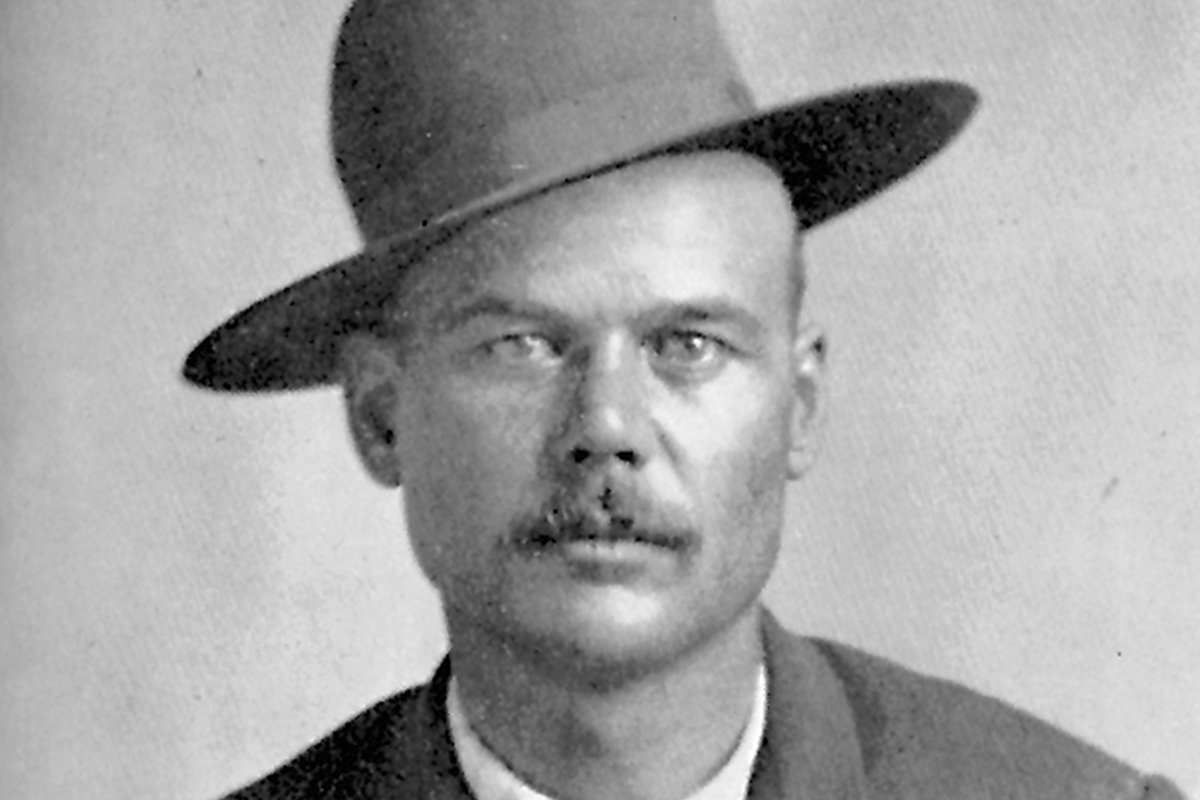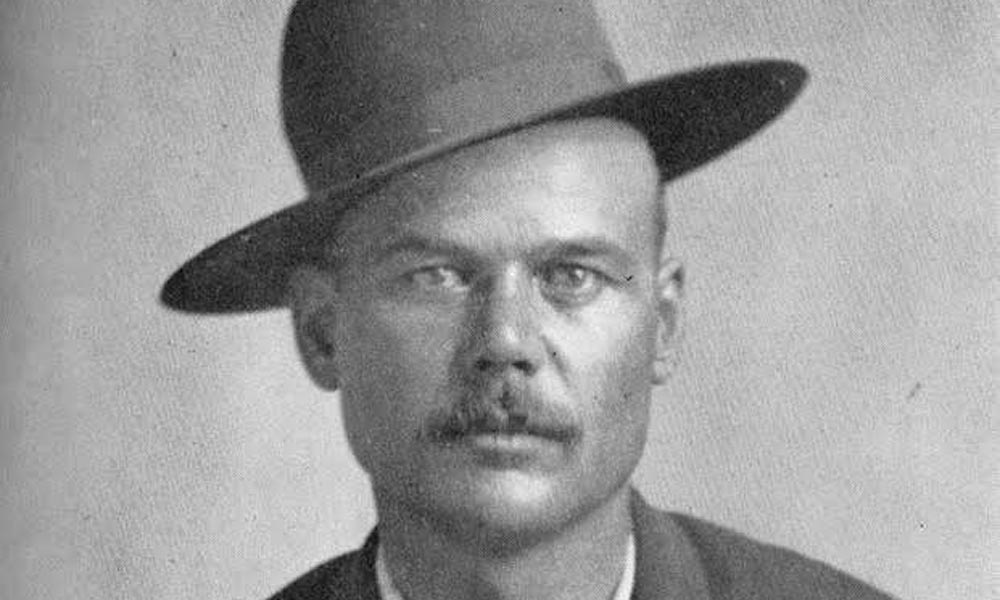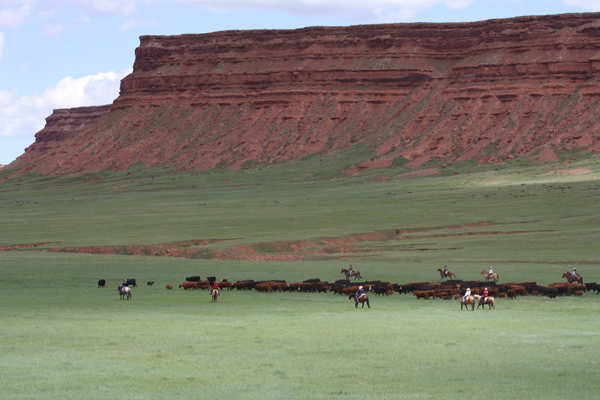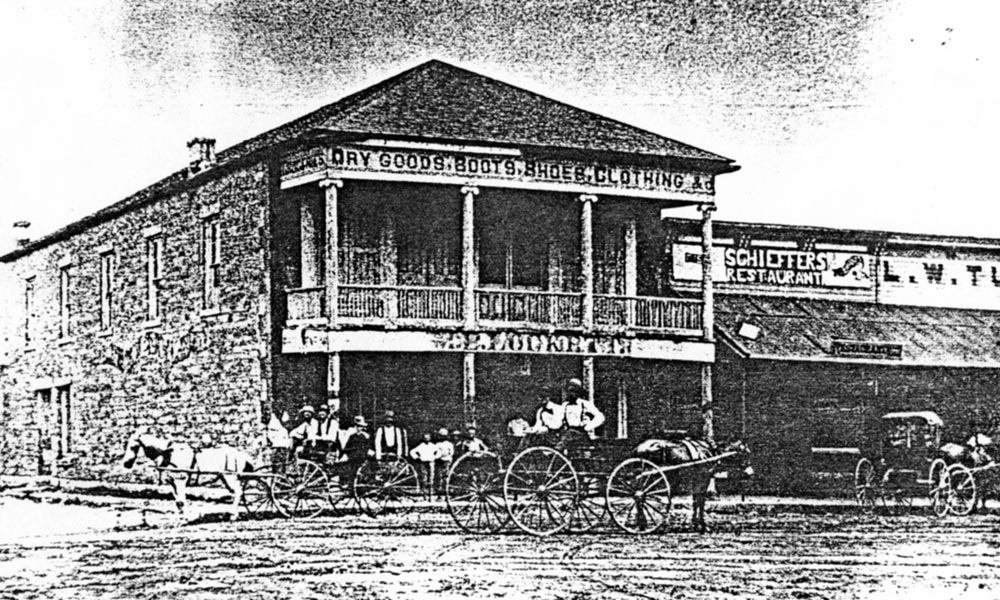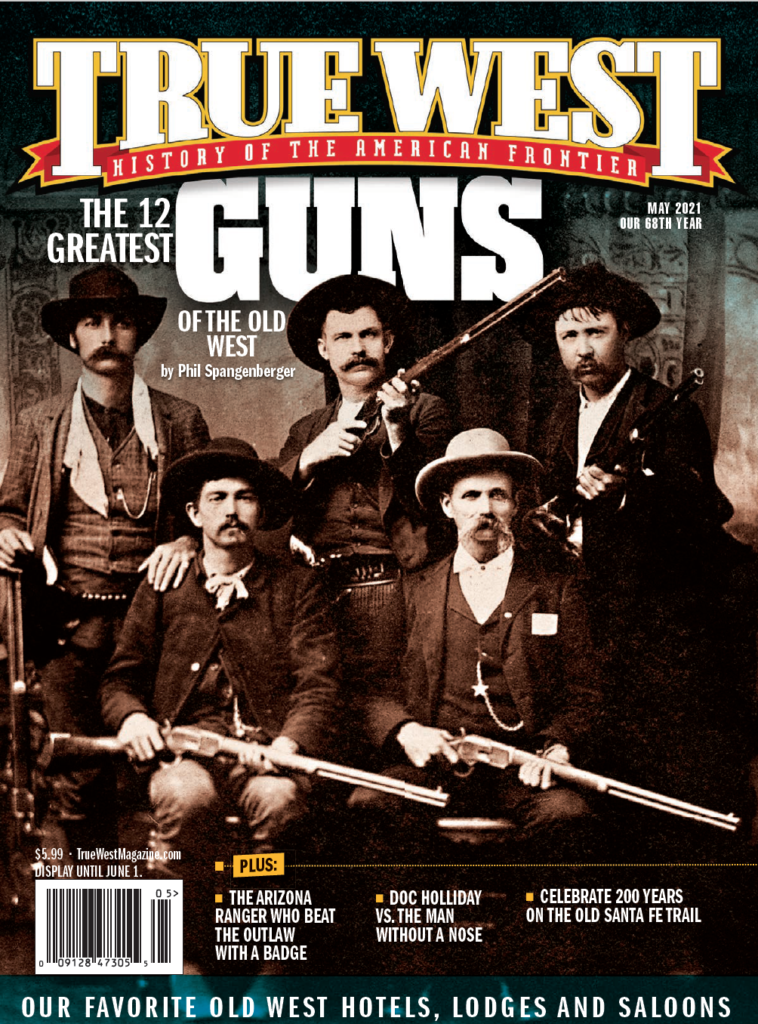The Arizona deputy sheriff lived a double life as a highwayman, gang leader and train robber.
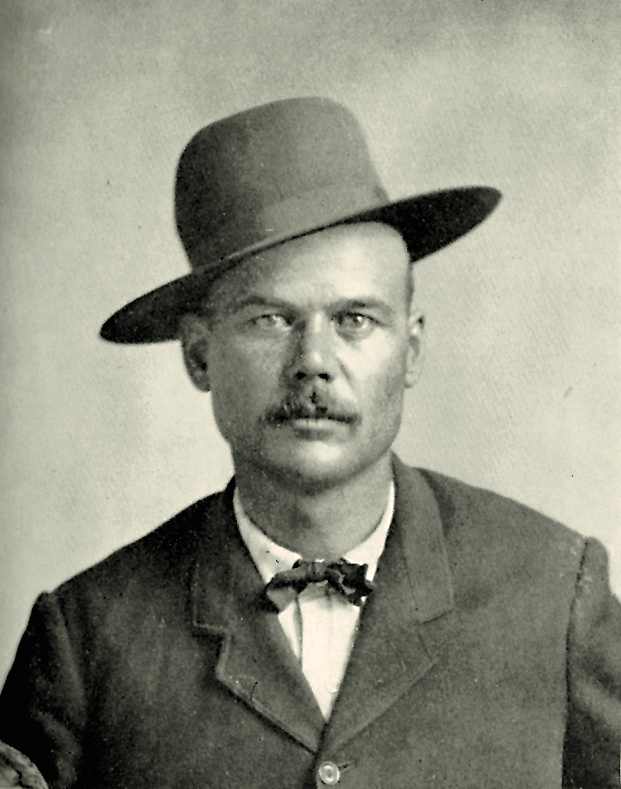
Territory’s most notorious outlaws.
– All Images and Bob Boze Bell Illustrations Courtesy True West Archives Unless Otherwise Noted –
Burt Alvord wasn’t exactly a household name among Arizona’s notorious outlaws. They also said he wasn’t the sharpest knife in the drawer. It was claimed his IQ was a little bit less than his waist size. His major interests were poker, pool, guns and practical jokes. On the other hand, he worked for a time in the late 1880s as a deputy sheriff for Cochise County Sheriff John Slaughter, who declared him fearless. Cochise County was blessed with a profusion of colorful characters, so Burt fit right in with the rest.
Boxing and wrestling were two of the most popular sports in the mining camps, and there was always a lot of money in the purse for the winner.
One time Burt and a diminutive Irishman and fellow practical joker named Biddy Doyle hatched a wrestling match scheme pitting Biddy against a muscular, not-too-bright Cornish miner in Bisbee. The match took place in a mule manure pile in front of the Copper Queen Mine. The folks in Bisbee bet heavily on the “Cousin Jack,” but unbeknownst to them, Burt had bribed him to take a fall. Then he bet heavily on the little Irishman. The big guy took the fall in the first round when Biddy threw him to the ground and pushed his face into the manure. Before the crowd had time to react, Burt grabbed the purse, and he and Biddy hightailed it for Tombstone. It goes without saying that for quite some time Burt and Biddy were personae non gratae around Bisbee.

– Photo of Tombstone, 1909, Courtesy Library of Congress –
The Constable Outlaw
In 1897, Burt took a job as constable in the town of Willcox, Arizona Territory, during which time he planned and staged one of the most bizarre train robberies in Western history. Burt’s plan was to use his job as a lawman to screen his moonlighting as leader of a gang of train robbers. The plan included his drinking cronies, Billy Stiles, Matt Burts and Bill Downing. They would rob the westbound Southern Pacific Railroad between Willcox and Cochise Station. There was a long incline between the two that caused the trains to slow to a crawl. It was a perfect place for one of the bandits to hop aboard the engine, force the engineer to stop, uncouple the passenger cars from the engine and express car, then proceed down the tracks a mile or so to where the others were waiting.
Burt’s alibi was cleverly planned. The four would, ostensibly, be playing poker at the time the robbery occurred.
On the evening of September 9, 1899, the boys were sitting in the back room engaged in a poker game at Schwertner’s Saloon in Willcox (today’s Rex Allen Museum). Burt had bribed a porter to carry a round of drinks into the room every few minutes and emerge moments later with a tray of empty glasses and casually assure the patrons that Burt and his pals were having a serious game of poker behind those closed doors and didn’t want to be disturbed.
When the train pulled into Willcox, the four laid down their cards and exited a side window, mounted their horses and vanished into the night.
The robbery went smoothly, and afterwards, Alvord stashed the loot. Anybody spending money freely around town would be suspect, and Burt wasn’t taking any chances. He’d wait until things cooled down before divvying up the loot. The boys re-entered the back room of the saloon through the side window.
Meanwhile, the engineer backed the train into Willcox and gave the alarm. Someone suggested they alert the town marshal, who was playing poker across the street at Schwertner’s Saloon.
Burt was noticeably shocked when told of the robbery. “Great Scott,” he shouted, pointing a finger at his three fellow train robbers, “I need volunteers for a posse, you, you and you.”
The next morning they arrived back in town wearing weary faces and claiming they’d lost the trail. There were a few raised eyebrows and rumors floating around town. Some of those rumors pointed to the constable as the ringleader. Burt tried to defuse the gossip by claiming everyone knew he was too dumb to pull off such a clever caper.
Alvord was feeling pretty good about himself. For now, it looked like he’d planned and executed the perfect crime. In all the annals of train robberies in the Old West, it was the only time the robbers and the posse that pursued them were one and the same.
Lawman and future Arizona Ranger Bert Grover suspected Alvord was behind the scheme, so he managed to coerce a confession out of the porter, who then skipped town. Without the porter, Grover would be hard-pressed to build a case. It looked like Burt had planned and executed a perfect train robbery, and so he proceeded to plan another one.
Jeff Milton vs. The Burt Alvord Gang
The railroad linking Benson to Nogales arrived in 1881 in what became the town of Fairbank on the San Pedro River. It was the closest rail link to the boomtown of Tombstone, at the time one of the largest cities in the West.
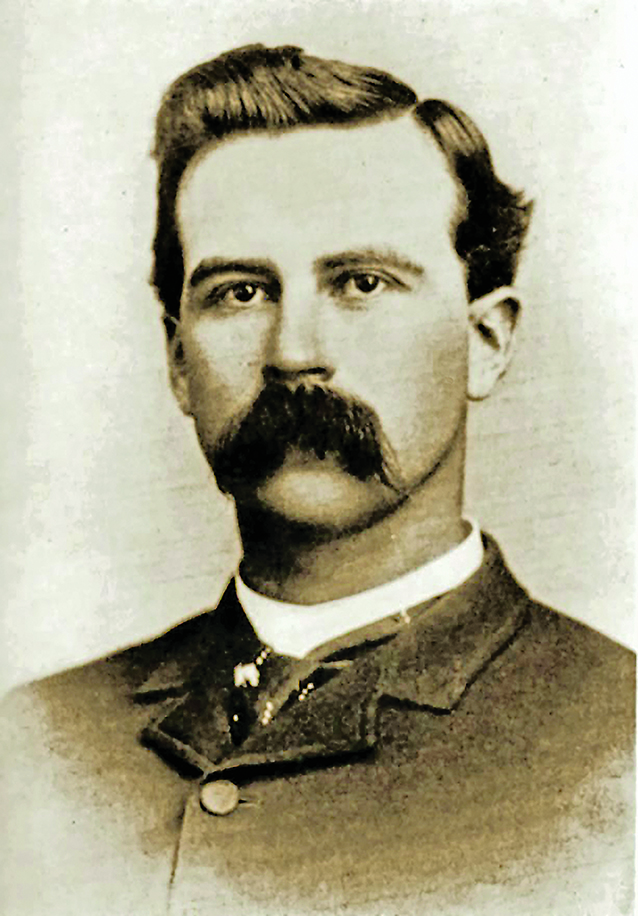
On February 15, 1900, the train station was the scene of a sensational attempted train robbery. In the annals of the Old West, it might have been the only time a train robbery was attempted in a station, in broad daylight and in front of live witnesses. Five outlaws, including Three-Finger Jack Dunlap and Bravo Juan Yoas, were all members of the Alvord gang. Before the arrival of the train, the boys were loitering around the station pretending to be drunken cowboys. What the boys didn’t know was the Wells Fargo messenger on that run from Nogales just happened to be the famous ex-Texas Ranger and Texas lawman, Jeff Milton. Not expecting any danger as the train approached the station, Milton was standing in the open doorway.
Suddenly, the desperados jerked their pistols and opened fire on Milton. A bullet ripped into his left shoulder, severing an artery.
Seriously wounded, he fell back inside the car and dropped behind a trunk. His gunfighter instincts took over, and he grabbed a Wells Fargo short-barrel ten-gauge shotgun, tossed the keys to the strongbox into a dark corner of the express car and waited for the bandits to charge.
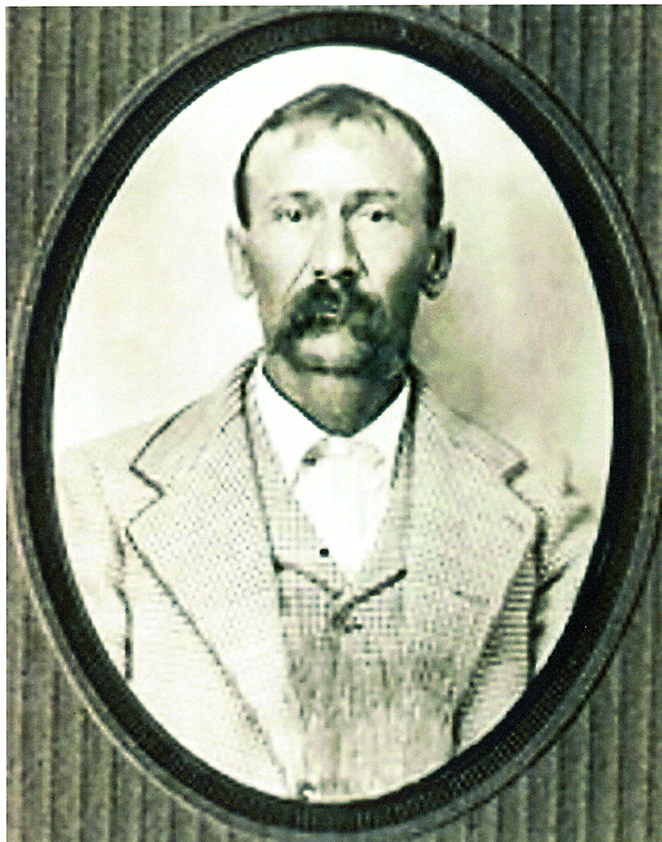
Thinking Milton was dead, the bandits rushed toward the open door. As they drew near, he arose from behind the trunk and opened up with both barrels. Three-Finger Jack was in the lead, and he caught a load of buckshot in the belly. Bravo Juan had just enough time to turn around. He caught a load in the seat of his pants. It was not a good place to be shot when one was going to make his getaway on horseback.
The outlaws quickly decided to clear out and rode away empty-handed. Three-Finger Jack was mortally wounded and was slowing their escape, so a few miles from Fairbank, his pals decided to leave him to die along the trail.
Meanwhile, back in Fairbank, a posse was organized, and trackers easily picked up the trail leading to where Jack lay dying.
Jack was much annoyed at being left behind by his cronies and was only too willing to give lawmen enough information to arrest all the gang members, including the gang leader who doubled as Willcox constable, Burt Alvord.
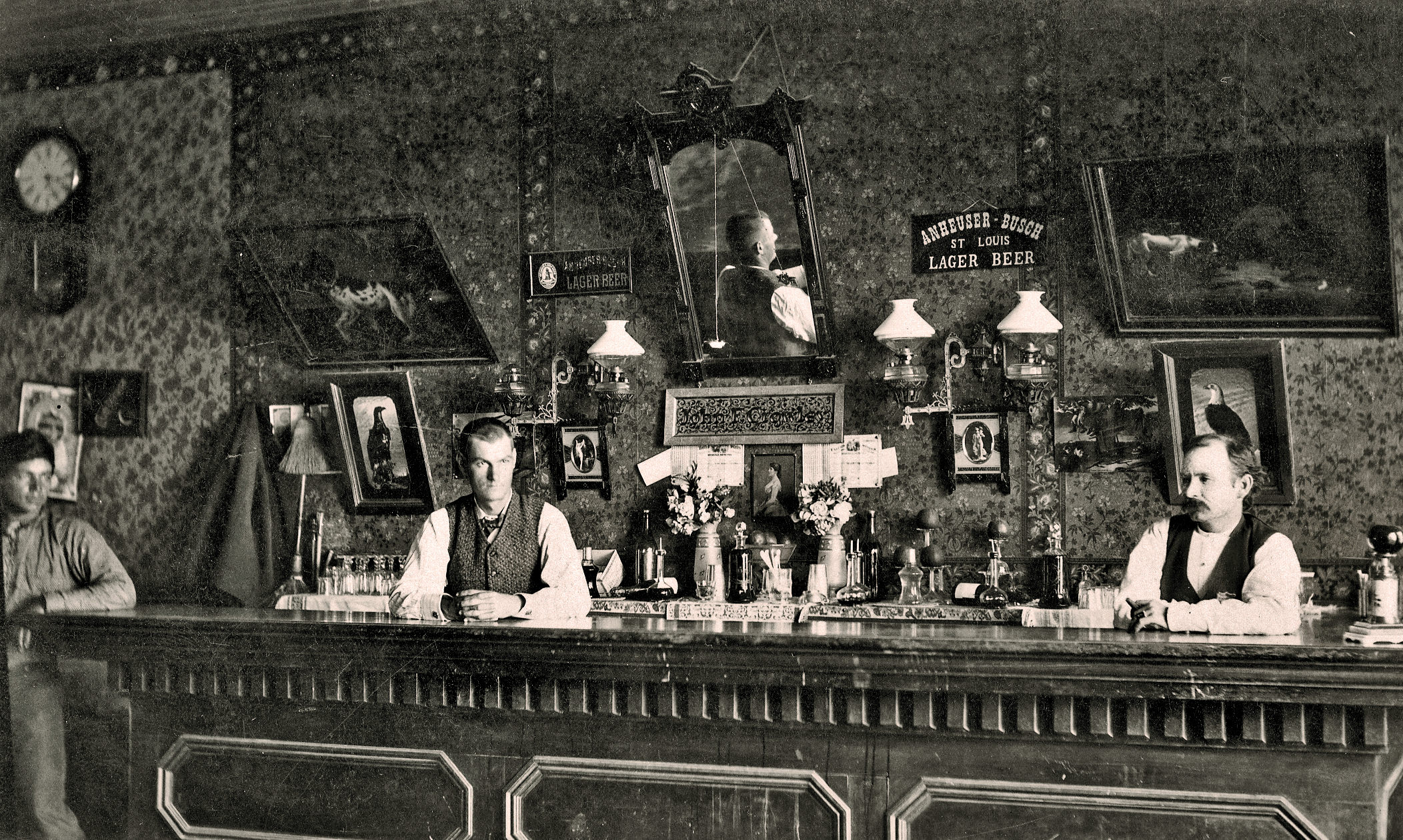
The gang was rounded up, brought to Tombstone and locked up in the courthouse jail. Billy Stiles decided to turn rat and testified against his friends. He was released, and on April 7, he brazenly walked into the Tombstone jail, stuck his gun in the jailer’s ribs and forced him to release Alvord, who then took the jailer’s keys and opened the rest of the cells. Some of the prisoners fled, however others chose to take their chances with a jury. The escapees grabbed guns and rifles and headed out the door. When the jailer made one last attempt to stop them, Billy shot him in the leg.
Burt looked at the incident as just another escapade. A few days later, the sheriff received an envelope with the jail keys inside and a note from Burt that said, “Tell the boys we’re all eating well.”
Mossman’s Outlaw Posse vs. Chacon
Stiles and Alvord headed for Mexico. Two years later, Arizona Ranger Capt. Burt Mossman heard the two desperadoes wanted to come home. In January 1902, he got word to them that if they would help him capture Augustine Chacon, they could share the reward money, and he’d testify in court to their good character. He even went so far as to put Billy Stiles on the payroll as a ranger. Alvord’s wife was threatening to divorce him if he didn’t come home soon, something that gave Captain Mossman some added leverage.
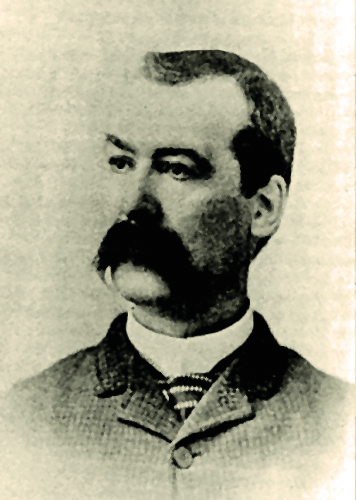
Chacon was a resident of Sonora but did most of his mischief in Arizona, leading his gang on far-flung forays of pillage and plunder.
Each time they’d hightail it back to Sonora, where he lived in a well-defended fortress-like ranch. To his admirers Chacon was more of a Robin Hood than a border bandit.
Old-timers claimed Chacon had 30 notches carved on the butt of his smoke wagon.
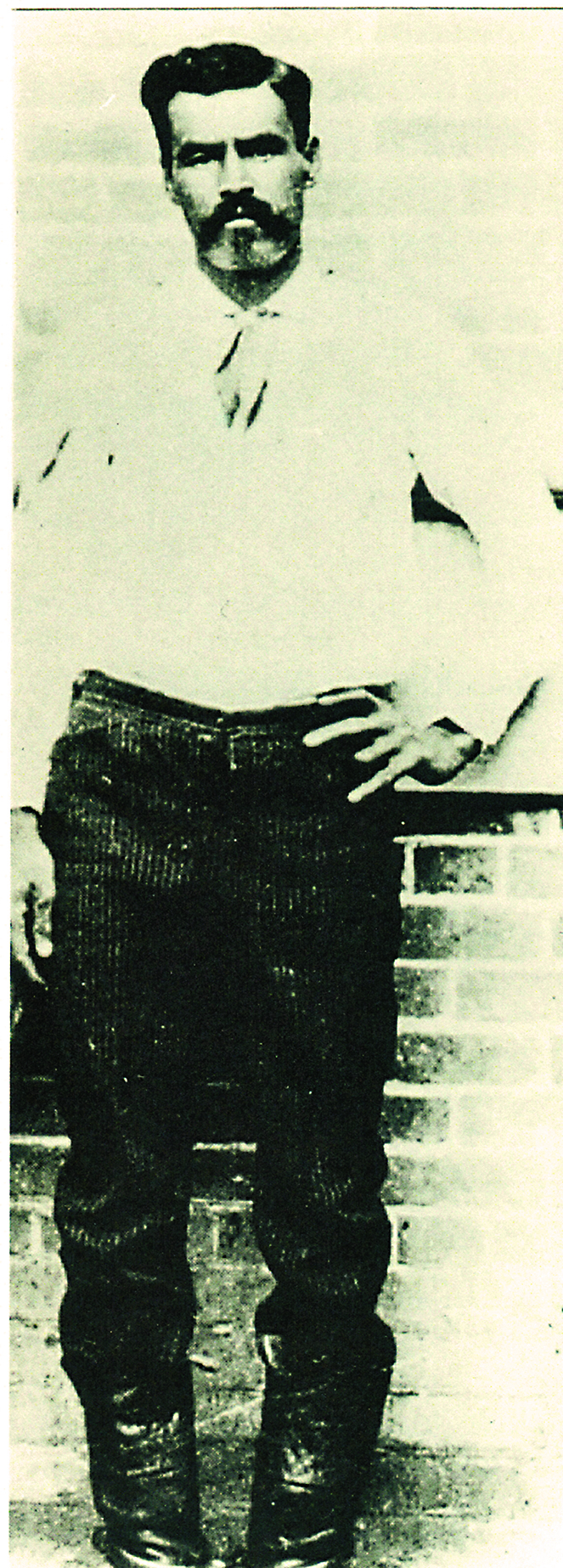
His undoing came in 1896 when he killed a deputy sheriff named Pablo Salcido in cold blood at Morenci. Lawmen caught up with him before he reached the border, and he was brought to Solomonville to stand trial for murder. A jury convicted Chacon, and he was sentenced to hang. It looked like the end of the line for one of the Southwest’s most notorious outlaws.
But Chacon had an ace up his sleeve. He spent the weeks before his execution plotting an escape.
He was quite a handsome man and a favorite of the young senoritas. He seemed to have one in every village on both sides of the border. He was tall and lean, with a thick shock of hair. Women were always eager to please him. He had other admirers too. The poor Mexicans living in the nearby mining camps saw the handsome outlaw as a frontier Robin Hood. They called him El Peludo—the Hairy One. And they were eager to help him escape.
A pretty young senorita inserted a hacksaw blade in the spine of a family Bible and smuggled it into Chacon’s cell. Among his cellmates were members of a mariachi band, consisting of a squeaky violin, guitar and concertina.
Each night while Chacon sawed on the bars, the band let forth with some loud, lusty corridos to drown out the noise.
On the night he was to make his break, Chacon’s pretty companion showed up at the jail, batted her long eyelashes and with a sweet smile that promised much, lured the night jailer out for a midnight stroll. With the jailer thus preoccupied, Chacon escaped into the night.
Augustine Chacon continued his wild and woolly ways, but the Arizona Rangers were hot on his trail.
In April 1902, Capt. Burt Mossman rode into Mexico posing as a fugitive. He learned Alvord was holed up west of the village of San Jose de Pima. Two days later, he rode into the lair of the lawman-turned-outlaw. The hilltop adobe house was a veritable fortress with loopholes, battle shutters on the doors and windows and a commanding view of the surrounding terrain. Inside one of the rooms, horses were saddled and ready to ride out at a moment’s notice.
Alvord spent some time thinking about Mossman’s offer. He missed his wife and wanted to go home, but he was either afraid or didn’t want to betray Chacon. Finally, he agreed to cooperate and set up Chacon so the ranger could make the capture. Mossman then rode north to await word from Alvord on where he could meet Chacon. Billy Stiles would be the messenger.
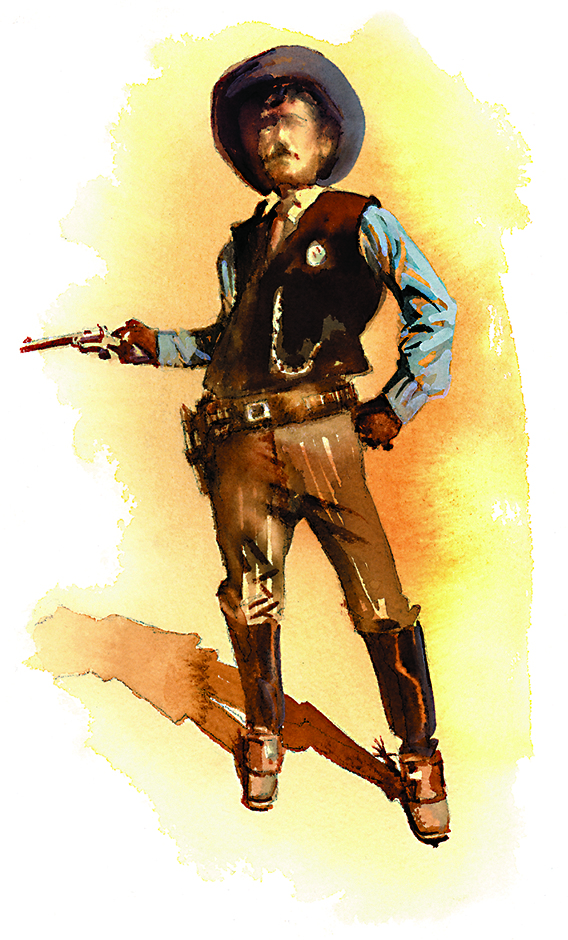
Several months later, in late August, Stiles brought word that he, Mossman and Alvord would meet Chacon at a spring 16 miles south of the border on the first day of September. To entice Chacon out in the open, they offered to cut him in on a plan to steal some prize horses from a ranch in the San Rafael Valley of southern Arizona.
On September 1, Mossman and Stiles rode to the spring, but Alvord and Chacon failed to show. That evening they rode back across the border to spend the night and then returned the next day. Around sunset the following day, they met the two outlaws on the trail. Both were heavily armed. Along with his rifle and pistol, Chacon was packing a large knife. Despite assurances by Mossman, claiming that he too was a fugitive, the cagey bandit was suspicious. His hand was never far from the butt of his pistol.
That night they made camp and Mossman nervously waited out the sleepless hours, his coat pulled up, concealing his face. Beneath the coat, his pistol was trained on Chacon. The ever-vigilant Chacon never let his guard down either. He refused to let any of the men get behind him. To make matters worse, Mossman wasn’t sure he could trust either Alvord or Stiles not to betray him.
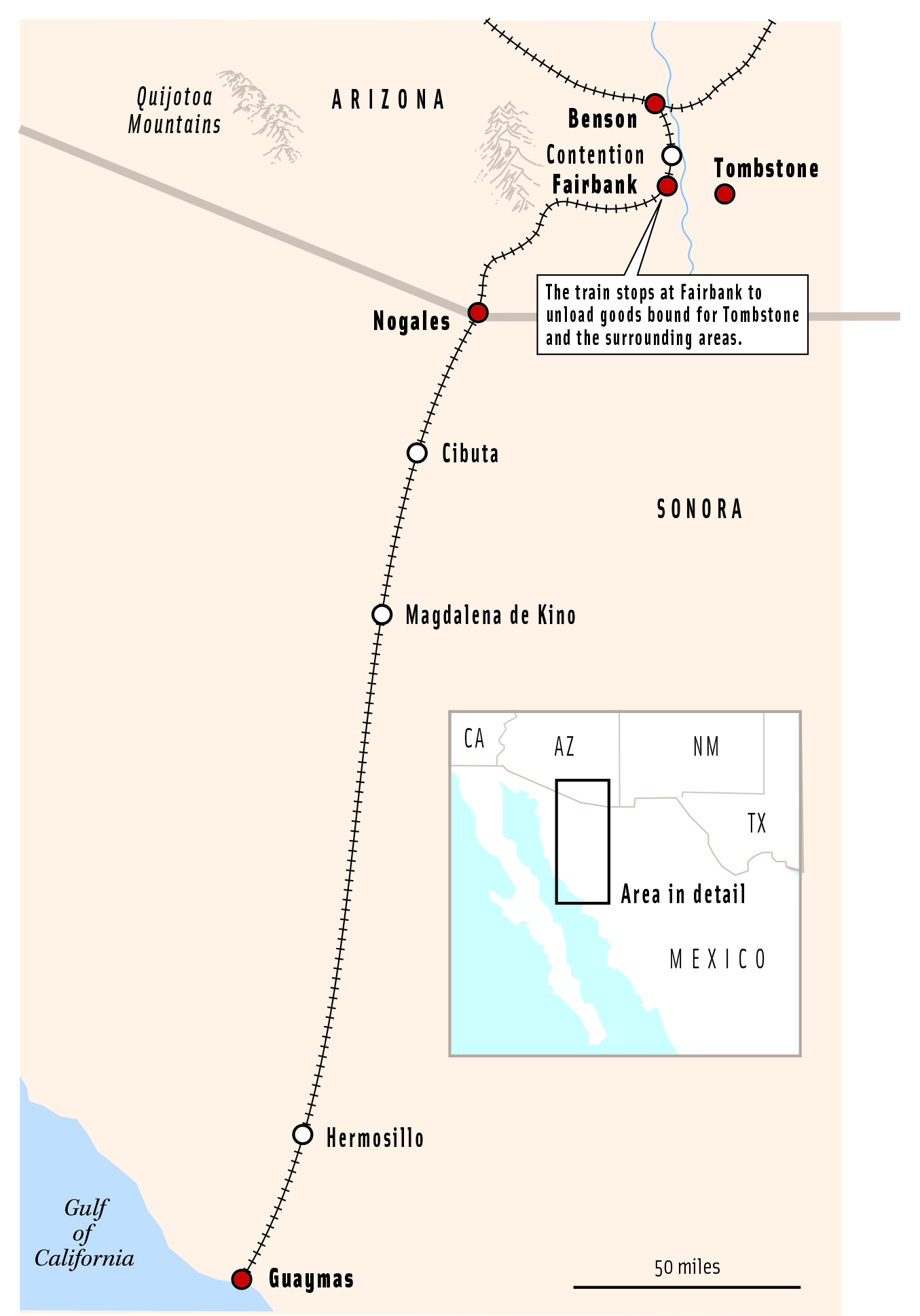
At daybreak, the men got up and started a fire. While Chacon was fixing breakfast, Burt slipped next to Mossman and quietly said he’d done his part and was heading out. He also warned the ranger not to trust Billy Stiles. Then he told Chacon he was going for water and would return shortly. While the three men were eating, Chacon’s eyes narrowed, and he became suspicious, wondering what was taking Alvord so long to return.
After breakfast, Chacon reached in his pocket and took out some corn husk cigarettes and offered them to Stiles and Mossman. As they hunkered down around the fire having a smoke, Mossman saw his chance. He let his cigarette go out, then reached into the fire with his right hand, picked up a burning stick and re-lit his cigarette. As he reached out and tossed the stick back into the fire, Mossman’s hand slid past his holster. Quick as a flash, the ranger pulled his revolver and got the drop on the surprised bandit. He ordered Chacon to put his hands up. The outlaw cursed but did as he was told. Next, the ranger told Stiles to remove Chacon’s knife and gun belt. And, to Billy’s surprise, told him to drop his gun belt also. He then ordered both men to step back while he gathered up the rifles and pistols. After ordering Stiles to handcuff Chacon, the trio mounted up and rode for the border.
Mossman decided to avoid Naco, fearing Chacon might have friends there. Instead, he headed across the San Pedro Valley about 10 miles west. Stiles rode in front, leading Chacon’s horse, while Mossman covered them both from the rear with his Winchester 30-40. As they neared the border, Chacon began to balk, so Mossman unstrapped his riata and dropped a loop around his neck, warning that he would drag him across the border if necessary. The outlaw cursed again but caused no more trouble.
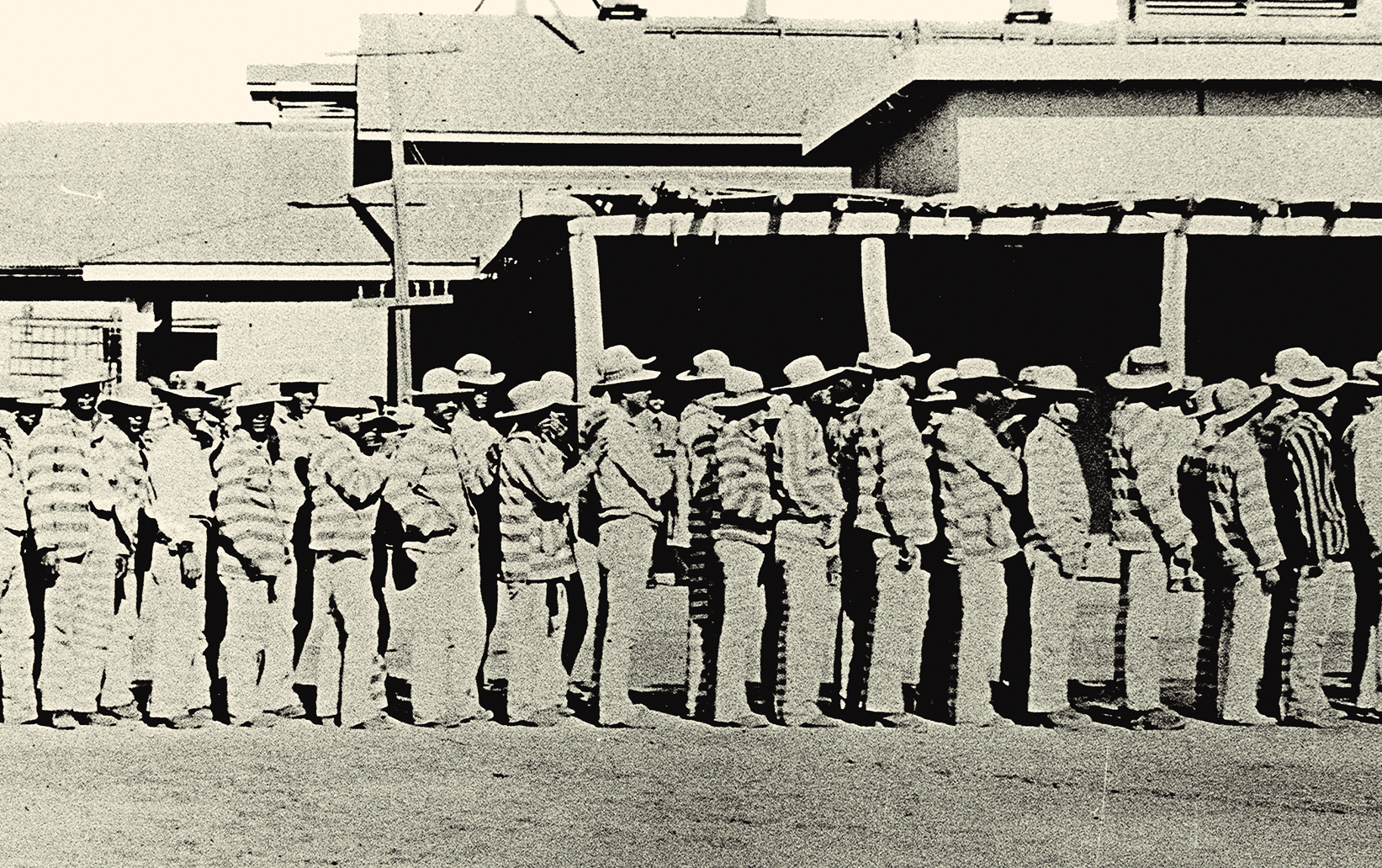
They arrived at Packard Station on the El Paso and Southwestern Railroad line just as the train to Benson was passing through. Mossman’s Scots-Irish luck was holding. He flagged it down and they made the final 50 miles to Benson riding the steel rails. At Benson, they were met by Graham County Sheriff Jim Parks, who was most eager to take Chacon back to the jail at Solomonville, which he’d escaped from in 1897, and to his long-awaited rendezvous with the hangman.
Word spread quickly of Mossman’s daring capture of the outlaw Chacon and caused a lot of excitement around the territory. A few eyebrows were raised when it was pointed out that his ranger commission had expired four days before he captured Chacon, and that he’d arrested the bandit on foreign soil. The Mexican government expressed outrage at the flagrant violation of their sovereign soil. Mossman stayed around Arizona just long enough to keep his promise to Billy Stiles. After testifying for Billy, he boarded a train and headed for New York City for an extended visit until the furor subsided.
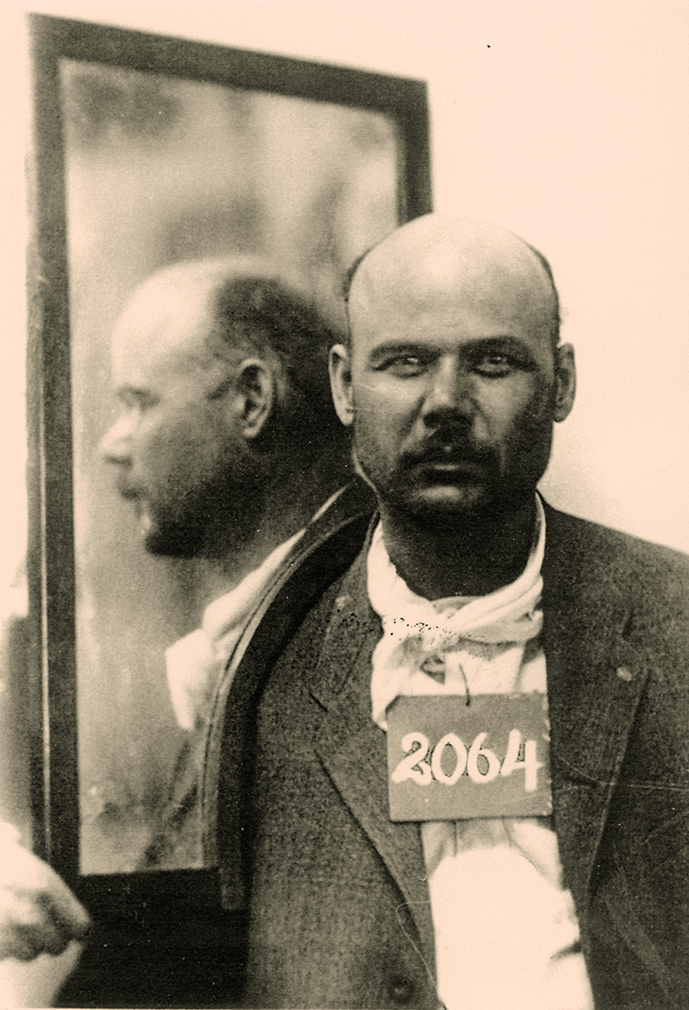
Alvord’s Final Years
On September 10, 1902, Alvord surrendered in Tombstone after helping Mossman capture Chacon.
On December 8, 1903, Burt was sentenced to two years at Yuma Territorial Prison, but Burt and Billy were up to their old tricks, and on December 17, the two escaped the Tombstone jail and headed for Mexico. On February 6, 1904, they robbed a $7,000 gold bar on the Magdalena Road. Two weeks later, the Arizona Rangers crossed the border and ran them to the ground near Naco. Stiles managed to get away, but Burt was slightly wounded and captured. He was taken to the Tombstone jail, then to the Yuma Territorial Prison.
Strangely, despite his escape and robbery in Mexico, Alvord’s term was counted from the time of sentencing. He was released from prison early, on October 9, 1905, two weeks before scheduled, and there must have been a reason. On September 20, 1905, a warrant was placed with the U.S. Marshal of Arizona on Burt for robbery in Mexico. Mexico wanted him extradited, but Burt had “flown the coop.”
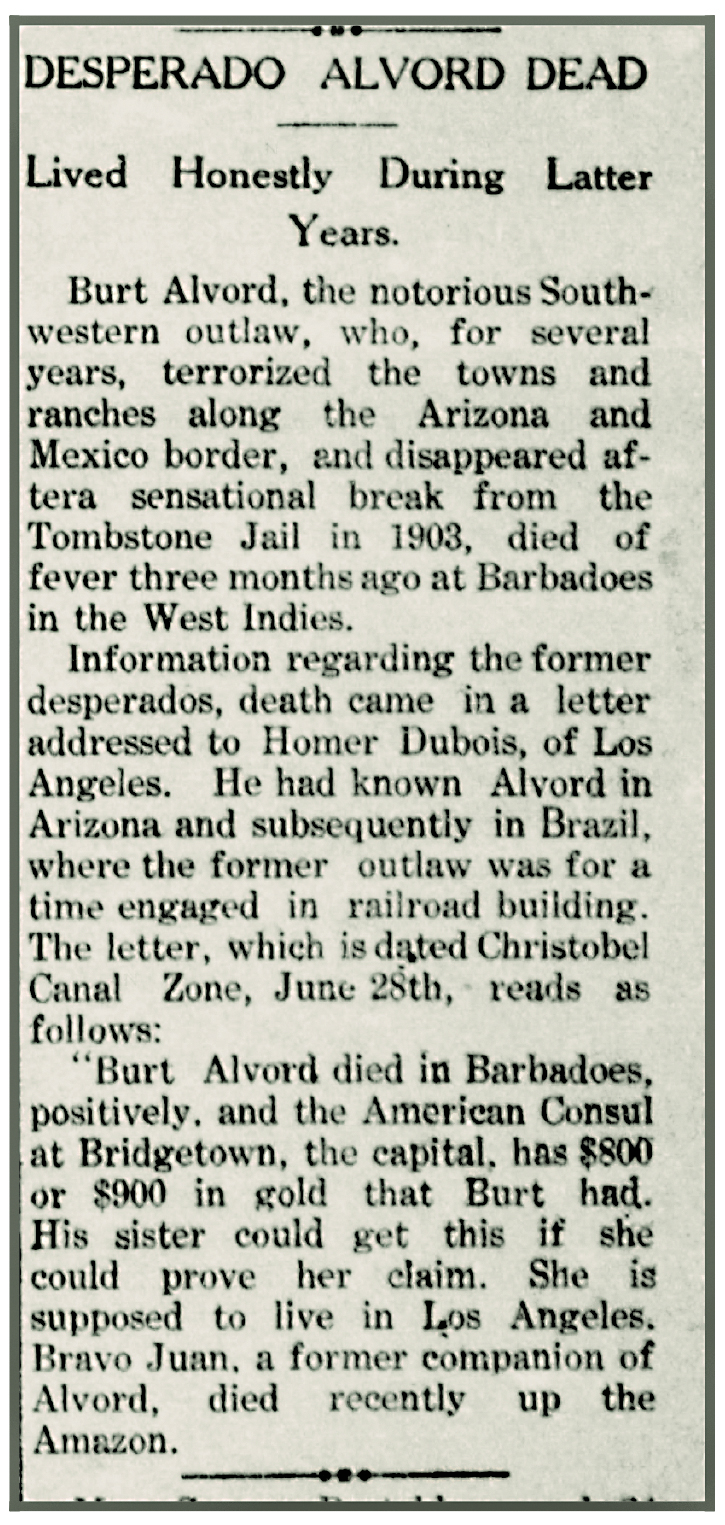
– July 29, 1910 “Graham Guardian” (Safford, A.T.) News Clipping Courtesy Newspapers.com –
He went to his sister, Mary Shoults in Los Angeles, changed his name to Tom Wright and borrowed money to go to Panama, where he worked on the canal in late 1905. For years Burt disappeared from the pages of history. Recently, we learned the rest of the story. Burt helped build a railroad line along the Amazon River in Brazil. There, he contracted yellow fever and was sent along with other ailing workers to the island of Barbados in the Caribbean’s West Indies, where he died November 24, 1909.
Marshall Trimble, the official Arizona state historian since 1997, has been writing his True West “Ask the Marshall” column since 2000. He is also the author of more than 20 books on Arizona and the West, including Arizona Outlaws and Lawmen: Gunslingers, Bandits, Heroes and Peacekeepers.
Author’s Note:
For further reading: The Odyssey of Burt Alvord: Lawman, Train Robber, Fugitive by Don Chaput (Westernlore Press), When Outlaws Wore Badges by Melody Groves (TwoDot), The Arizona Rangers by Bill O’Neal (Eakin) and Arizona Outlaws and Lawmen by Marshall Trimble (History Press)

